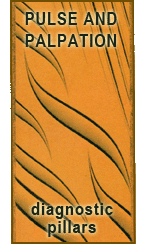Pulse Qualities and Mechanisms (A Quick Guide)

Pulse diagnosis is among the more difficult aspects of Chinese medicine to master. One reason for this is incomplete education.
In this article, pulse qualities are described, along with the mechanisms behind these findings and of course their therapeutic indications.
Understanding mechanisms simplifies this study greatly. Complex pulses such as the soggy (ru mai) aren’t so complex when you understand the basis for it’s quantifiable parameters.
| SPEED | FAST | SLOW |
| STRENGTH | FORCEFUL | FORCELESS |
| LENGTH | LONG | SHORT |
| WIDTH | WIDE | THIN |
| DEPTH | SUPERFICIAL | DEEP |
| RHYTHM | REGULAR | IRREGULAR |
| ABNORMAL PULSE SHAPES | CHOPPY, WIRY, SLIPPERY | |
| FAST AND SLOW | ||
|---|---|---|
| PULSE | INDICATIONS | MECHANISM |
| Fast Pulse | Heat | Heat accelerates movement. |
| fast+forceful | excess heat | |
| fast+thin | deficiency heat | |
| Slow Pulse
Water element pulse |
cold | Cold impedes movement. The so-called “Athletic Pulse” is also a slow pulse, but it only indicates cardiac health. |
| FORCEFUL AND FORCELESS | ||
|---|---|---|
| PULSE | INDICATIONS | MECHANISM |
| FORCEFUL Pulses | excess | |
| Surging Pulse (floating, wide, forceful, comes stronger than it goes) Fire element pulse |
excessive heat | Heat stimulates the Heart’s function of commanding the Blood leading to increased cardiac output and the forceful pulse. However, heat damages the yin, which leads to a component of deficiency in this pulse. The deficient component is the downslope of the pulse wave which is weaker than the upslope of the pulse wave. Also, this is often considered a floating pulse. When the yin is damaged, it loses its root and floats. |
| Forceless Pulses | deficiency | deficiency of Qi or Yang gives rise to the forceless pulse. |
| LONG AND SHORT | ||
|---|---|---|
| PULSE | INDICATIONS | MECHANISM |
| Long Pulse | excessive heat | Heat accelerates and expands. When the pulse is long and too forceful, this is excessive heat. When the long pulse is moderate in force, this is a healthy pulse. |
| Short Pulse | ||
| short+forceful | Qi stagnation | Stagnation prevents Blood from filling the vessel. |
| short+forceless | Qi deficiency | Qi can’t push Blood hard enough to fill the vessel. |
| WIDE AND THIN | ||
|---|---|---|
| PULSE | INDICATIONS | MECHANISM |
| Wide Pulse | heat | |
| wide+forceful | excessive heat | Heat accelerates and expands. |
| wide+forceless | deficiency heat | Yang expands the width of the vessel because Yin is too deficient to anchor it. |
| Thin Pulse | deficiency of Qi, Blood, or Yin | Qi, Blood, or Yin can’t fill the vessel with fluid or pressure to expand the width of the vessel. |
| SUPERFICIAL AND DEEP | ||
|---|---|---|
| PULSE | INDICATIONS | MECHANISM |
| Superficial Pulse Metal element pulse |
||
| superficial+forceful | exterior syndrome | Yang floats to the exterior (as Wei Qi) to fight off invasion of exterior pathogenic factor. This is reflected metaphorically in the superficial pulse. |
| superficial+forceless | Yin deficiency | Yang floats to the exterior because Yin cannot anchor it. This is reflected metaphorically in the superficial pulse. |
| Deep Pulse | ||
| deep+forceful | internal cold | pathological cold both injures Yang and impedes its rising. This is reflected metaphorically in the deep pulse. |
| deep+forceless | Yang deficiency | A deficiency of Yang gives rise to the inability for Qi and Blood to lift upwards. This is reflected metaphorically in the deep pulse. |
| REGULAR AND IRREGULAR | ||
|---|---|---|
| PULSE | INDICATIONS | MECHANISM |
| Regular Pulse | health | |
| Intermittent Pulse (regularly irregular) |
Rather than focusing too much on the indications of this pulse, I want you to remember that this may be a red flag for you and a referral to a cardiologist may be indicated. | |
| Abrupt Pulse (rapid, irregular rhythm) |
heat stagnation or stagnation heat | This pulse indicates stagnation that gives rise to heat, or heat that is causing stagnation. In either case, we have stagnation and heat. |
| Knotted Pulse (slow, irregular rhythm) |
Blood Stagnation | pathological factors (likely cold) impede movement of Blood |
| ABNORMAL PULSE SHAPES | ||
|---|---|---|
| PULSE | INDICATIONS | MECHANISM |
| Choppy Pulse | Blood Stagnation | |
| choppy+forceful | Blood Stagnation | excessive pathological factors impede movement of Blood |
| choppy+forceless | Blood Stagnation | lack of Qi, Blood, or Jing leads to vessels that aren’t filled which inhibits free flow of Blood. |
| Wiry Pulse
Wood element pulse |
Stagnation | Nei Jing says “tendons are the mother of vessels” which is to say that when the Liver becomes dry, so do the tendons, which leads to a hardness in the pulse as it loses the vessels lose their flexibility.
Another mechanism is Qi stagnation prevents Blood from circulating outward and so the pressure remains high in the vessels causing the hard (wiry) pulse. |
| Slippery Pulse
Earth element pulse |
Dampness | Dampness in the Blood increases its viscosity giving rise to a pulse that lacks corners. |
| Heat | Heat accelerates the movement of the Blood giving rise to the perception of the pulse losing its corners. | |
 Last modified: September 11, 2009
Last modified: September 11, 2009  Tags: Diagnosis, Palpation, study guide В· Posted in: Pulse-Palpation
Tags: Diagnosis, Palpation, study guide В· Posted in: Pulse-Palpation
